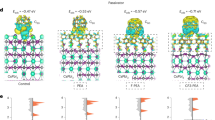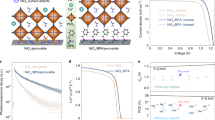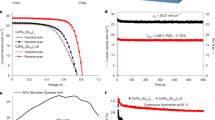Abstract
Wide-bandgap perovskites in monolithic perovskite/organic tandem solar cells face challenges such as unregulated crystallization, severe defect traps, poor energetic alignment and undesirable phase transitions, primarily due to unfavourable bottom interfacial contact. These issues lead to energy loss and device degradation. In this Article, we synthesize acidic magnesium-doped tin oxide quantum dots to modulate the bottom interface contact in wide-bandgap CsPbI2Br perovskite solar cells. This design balances physical, chemical, structural and energetic properties, passivating defects, optimizing energy band alignment, enhancing perovskite film growth and mitigating instability. We also elucidate the instability mechanism caused by alkaline-based tin oxide bottom contact, emphasizing the impact of the tin oxide solution’s acid/base properties on the stability and performance of the device. Consequently, the wide-bandgap CsPbI2Br solar cell achieves a power conversion efficiency of 19.2% with a 1.44 V open-circuit voltage. The perovskite/organic tandem solar cell demonstrates an efficiency of 25.9% (certified at 25.1%), with improved stability under various conditions.
This is a preview of subscription content, access via your institution
Access options
Access Nature and 54 other Nature Portfolio journals
Get Nature+, our best-value online-access subscription
$32.99 / 30 days
cancel any time
Subscribe to this journal
Receive 12 digital issues and online access to articles
$119.00 per year
only $9.92 per issue
Buy this article
- Purchase on SpringerLink
- Instant access to full article PDF
Prices may be subject to local taxes which are calculated during checkout





Similar content being viewed by others
Data availability
All data needed to evaluate the conclusions in the Article are present in the paper and/or the supplementary materials and are also available from the corresponding authors on reasonable request. Source data are provided with this paper.
References
Eperon, G. E., Hörantner, M. T. & Snaith, H. J. Metal halide perovskite tandem and multiple-junction photovoltaics. Nat. Rev. Chem. 1, 0095 (2017).
Lin, R. et al. All-perovskite tandem solar cells with 3D/3D bilayer perovskite heterojunction. Nature 620, 994–1000 (2023).
He, R. et al. Improving interface quality for 1-cm2 all-perovskite tandem solar cells. Nature 618, 80–86 (2023).
Lin, R. et al. All-perovskite tandem solar cells with improved grain surface passivation. Nature 603, 73–78 (2022).
Li, L. et al. Flexible all-perovskite tandem solar cells approaching 25% efficiency with molecule-bridged hole-selective contact. Nat. Energy 7, 708–717 (2022).
Xiao, K. et al. All-perovskite tandem solar cells with 24.2% certified efficiency and area over 1 cm2 using surface-anchoring zwitterionic antioxidant. Nat. Energy 5, 870–880 (2020).
Han, Q. et al. High-performance perovskite/Cu(In,Ga)Se2 monolithic tandem solar cells. Science 361, 904–908 (2018).
Bai, Y. et al. Dopant-free bithiophene-imide-based polymeric hole-transporting materials for efficient and stable perovskite solar cells. Adv. Mater. 34, e2110587 (2022).
Wang, X. et al. Highly efficient perovskite/organic tandem solar cells enabled by mixed-cation surface modulation. Adv. Mater. 35, e2305946 (2023).
An, Y. et al. Optimizing crystallization in wide-bandgap mixed halide perovskites for high-efficiency solar cells. Adv. Mater. 36, e2306568 (2023).
Jiang, S. et al. Synergistic electrical and light management enables efficient monolithic inorganic perovskite/organic tandem solar cells with over 24% efficiency. Energy Environ. Sci. 17, 219–226 (2024).
Brinkmann, K. O. et al. Perovskite-organic tandem solar cells with indium oxide interconnect. Nature 604, 280–286 (2022).
Chen, W. et al. Monolithic perovskite/organic tandem solar cells with 23.6% efficiency enabled by reduced voltage losses and optimized interconnecting layer. Nat. Energy 7, 229–237 (2022).
Best research-cell efficiency chart. NREL https://www.nrel.gov/pv/cell-efficiency.html (2024).
Wu, S., Liu, M. & Jen, A. K.-Y. Prospects and challenges for perovskite-organic tandem solar cells. Joule 7, 484–502 (2023).
Wu, S. et al. Redox mediator-stabilized wide-bandgap perovskites for monolithic perovskite-organic tandem solar cells. Nat. Energy 9, 411–421 (2024).
Zhang, Z. et al. Suppression of phase segregation in wide-bandgap perovskites with thiocyanate ions for perovskite/organic tandems with 25.06% efficiency. Nat. Energy 9, 592–601 (2024).
Beal, R. E. et al. Cesium lead halide perovskites with improved stability for tandem solar cells. J. Phys. Chem. Lett. 7, 746–751 (2016).
Luo, P. et al. Solvent engineering for ambient-air-processed, phase-stable CsPbI3 in perovskite solar cells. J. Phys. Chem. Lett. 7, 3603–3608 (2016).
Wang, Z. et al. Suppressed phase segregation for triple-junction perovskite solar cells. Nature 618, 74–79 (2023).
Li, W. et al. Phase segregation enhanced ion movement in efficient inorganic CsPbIBr2 solar cells. Adv. Energy Mater. 7, 1700946 (2017).
Ren, Z. et al. Room-temperature multiple ligands-tailored SnO2 quantum dots endow in situ dual-interface binding for upscaling efficient perovskite photovoltaics with high VOC. Light Sci. Appl. 10, 239 (2021).
Wang, P. et al. Gradient energy alignment engineering for planar perovskite solar cells with efficiency over 23. Adv. Mater. 32, 1905766 (2020).
Meng, Y. et al. Pre-buried ETL with bottom‐up strategy toward flexible perovskite solar cells with efficiency over 23%. Adv. Funct. Mater. 33, 2214788 (2023).
Wu, C. et al. MXene-regulated perovskite vertical growth for high-performance solar cells. Angew. Chem. Int. Ed. 61, e202210970 (2022).
Park, S. M. et al. Low-loss contacts on textured substrates for inverted perovskite solar cells. Nature 624, 289–294 (2023).
Liu, J. et al. Oxygen vacancy management for high-temperature mesoporous SnO2 electron transport layers in printable perovskite solar cells. Angew. Chem. Int. Ed. 61, e202202012 (2022).
Wang, Y. et al. Highly crystalized Cl-doped SnO2 nanocrystals for stable aqueous dispersion toward high-performance perovskite photovoltaics. Adv. Mater. 36, e2305849 (2023).
Roux, S. et al. Elimination and exchange of trifluoroacetate counter-ion from cationic peptides: a critical evaluation of different approaches. J. Pept. Sci. 14, 354–359 (2008).
Xu, Y. et al. Oxygen vacancies enabled porous SnO2 thin films for highly sensitive detection of triethylamine at room temperature. ACS Appl. Mater. Interfaces 12, 20704–20713 (2020).
Park, S. Y. & Zhu, K. Advances in SnO2 for efficient and stable n–i–p perovskite solar cells. Adv. Mater. 34, 2110438 (2022).
Raoui, Y., Ez-Zahraouy, H., Kazim, S. & Ahmad, S. Energy level engineering of charge selective contact and halide perovskite by modulating band offset: mechanistic insights. J. Energy Chem. 54, 822–829 (2021).
Jarzebski, Z. M. & Marton, J. P. Physical properties of SnO2 materials: I. preparation and defect structure. J. Electrochem. Soc. 123, 199C–205C (1976).
Sannino, G. V. et al. The role of Mg dopant concentration in tuning the performance of the SnO2 electron transport layer in perovskite solar cells. Sustain. Energy Fuels 7, 4855–4863 (2023).
Phung, N. et al. The doping mechanism of halide perovskite unveiled by alkaline earth metals. J. Am. Chem. Soc. 142, 2364–2374 (2020).
Yang, S., Duan, Y., Liu, Z. & Liu, S. Recent advances in CsPbX3 perovskite solar cells: focus on crystallization characteristics and controlling strategies. Adv. Energy Mater. 13, 2201733 (2022).
Han, Y. et al. Controlled n‐doping in air-stable CsPbI2Br perovskite solar cells with a record efficiency of 16.79%. Adv. Funct. Mater. 30, 1909972 (2020).
Atourki, L. et al. Effect of doping on the phase stability and photophysical properties of CsPbI2Br perovskite thin films. RSC Adv. 11, 1440–1449 (2021).
Chai, N. et al. Photoexcitation-induced passivation of SnO2 thin film for efficient perovskite solar cells. Natl Sci. Rev. 10, nwad245 (2023).
Yao, F. & Lin, Q. Charge carrier dynamics of organic cation-treated perovskites probed with time-resolved microwave conductivity. ACS Photonics 9, 3165–3171 (2022).
Jiang, Q. et al. Enhanced electron extraction using SnO2 for high-efficiency planar-structure HC(NH2)2PbI3-based perovskite solar cells. Nat. Energy 2, 16177 (2016).
Qin, M., Chan, P. F. & Lu, X. A systematic review of metal halide perovskite crystallization and film formation mechanism unveiled by in situ GIWAXS. Adv. Mater. 33, 2105290 (2021).
Wang, Q. et al. Scaling behavior of moisture-induced grain degradation in polycrystalline hybrid perovskite thin films. Energy Environ. Sci. 10, 516–522 (2017).
Yun, J. S. et al. Humidity-induced degradation via grain boundaries of HC(NH2)2PbI3 planar perovskite solar cells. Adv. Funct. Mater. 28, 1705363 (2018).
Lin, J. et al. Thermochromic halide perovskite solar cells. Nat. Mater. 17, 261–267 (2018).
Xiang, W., Liu, S. & Tress, W. A review on the stability of inorganic metal halide perovskites: challenges and opportunities for stable solar cells. Energy Environ. Sci. 14, 2090–2113 (2021).
Yang, G. et al. Stable and low-photovoltage-loss perovskite solar cells by multifunctional passivation. Nat. Photonics 15, 681–689 (2021).
Jiang, Q. et al. Surface passivation of perovskite film for efficient solar cells. Nat. Photonics 13, 460–466 (2019).
Hou, Y. et al. Efficient tandem solar cells with solution-processed perovskite on textured crystalline silicon. Science 367, 1135–1140 (2020).
Fu, J. et al. 19.31% binary organic solar cell and low non-radiative recombination enabled by non-monotonic intermediate state transition. Nat. Commun. 14, 1760 (2023).
Yin, G. et al. Precursor engineering for all-inorganic CsPbI2Br perovskite solar cells with 14.78% efficiency. Adv. Funct. Mater. 28, 1803269 (2018).
Zhao, H. et al. A novel anion doping for stable CsPbI2Br perovskite solar cells with an efficiency of 15.56% and an open circuit voltage of 1.30 V. Adv. Energy Mater. 9, 1902279 (2019).
Kresse, G. & Joubert, D. From ultrasoft pseudopotentials to the projector augmented-wave method. Phys. Rev. B 59, 1758–1775 (1999).
Perdew, J. P., Burke, K. & Ernzerhof, M. Generalized gradient approximation made simple. Phys. Rev. Lett. 77, 3865–3868 (1996).
Yang, G. et al. Defect engineering in wide-bandgap perovskites for efficient perovskite–silicon tandem solar cells. Nat. Photonics 16, 588–594 (2022).
Wang, J. et al. 21.15%-efficiency and stable gamma-CsPbI3 perovskite solar cells enabled by an acyloin ligand. Adv. Mater. 35, 2210223 (2023).
Xiao, H. et al. Highly efficient and air-stable inorganic perovskite solar cells enabled by polylactic acid modification. Adv. Energy Mater. 13, 2300738 (2023).
Cui, Y. et al. A versatile molten-salt induction strategy to achieve efficient CsPbI3 perovskite solar cells with a high open-circuit voltage >1.2 V. Adv. Mater. 34, 2205028 (2022).
Xu, D. et al. Fluorine functionalized MXene QDs for near-record-efficiency CsPbI3 solar cell with high open-circuit voltage. Adv. Funct. Mater. 32, 2203704 (2022).
Chu, X. et al. Surface in situ reconstruction of inorganic perovskite films enabling long carrier lifetimes and solar cells with 21% efficiency. Nat. Energy 8, 372–380 (2023).
Yu, Y. et al. Dimensional engineering enables 1.31 V open-circuit voltage for efficient and stable wide-bandgap halide perovskite solar cells. Sol. RRL 6, 2200021 (2022).
Yu, Y. et al. Synergetic regulation of oriented crystallization and interfacial passivation enables 19.1% efficient wide-bandgap perovskite solar cells. Adv. Energy Mater. 12, 2201509 (2022).
Jiang, Q. et al. Compositional texture engineering for highly stable wide-bandgap perovskite solar cells. Science 378, 1295–1300 (2022).
Qin, S. et al. Constructing monolithic perovskite/organic tandem solar cell with efficiency of 22.0% via reduced open-circuit voltage loss and broadened absorption spectra. Adv. Mater. 34, 2108829 (2022).
Wang, C. et al. Suppressing phase segregation in wide bandgap perovskites for monolithic perovskite/organic tandem solar cells with reduced voltage loss. Small 18, 2204081 (2022).
Chen, H. et al. Regulating surface potential maximizes voltage in all-perovskite tandems. Nature 613, 676–681 (2023).
Yang, Z. et al. Enhancing electron diffusion length in narrow-bandgap perovskites for efficient monolithic perovskite tandem solar cells. Nat. Commun. 10, 4498 (2019).
Li, Z. et al. Wide-bandgap perovskite/gallium arsenide tandem solar cells. Adv. Energy Mater. 10, 1903085 (2019).
Braly, I. L., Stoddard, R. J., Rajagopal, A., Jen, A. K. & Hillhouse, H. W. Photoluminescence and photoconductivity to assess maximum open-circuit voltage and carrier transport in hybrid perovskites and other photovoltaic materials. J. Phys. Chem. Lett. 9, 3779–3792 (2018).
Yang, S. et al. A key 2D intermediate phase for stable high-efficiency CsPbI2Br perovskite solar cells. Adv. Energy Mater. 12, 2103019 (2021).
Liu, X. et al. Stoichiometric dissolution of defective CsPbI2Br surfaces for inorganic solar cells with 17.5% efficiency. Adv. Energy Mater. 12, 2103933 (2022).
Ozturk, T., Akman, E., Shalan, A. E. & Akin, S. Composition engineering of operationally stable CsPbI2Br perovskite solar cells with a record efficiency over 17. Nano Energy 87, 106157 (2021).
Guo, Z. et al. Dopant-free polymer HTM-based CsPbI2Br solar cells with efficiency over 17% in sunlight and 34% in indoor light. Adv. Funct. Mater. 31, 2103614 (2021).
Mali, S. S., Patil, J. V., Shinde, P. S., de Miguel, G. & Hong, C. K. Fully air-processed dynamic hot-air-assisted M:CsPbI2Br (M: Eu2+, In3+) for stable inorganic perovskite solar cells. Matter 4, 635–653 (2021).
Shan, S. et al. Manipulating the crystallization and phase transition for high-performance CsPbI2Br solar cells. Adv. Energy Mater. 13, 2203682 (2022).
Ding, Y. et al. A low-cost hole transport layer enables CsPbI2Br single-junction and tandem perovskite solar cells with record efficiencies of 17.8 % and 21.4 %. Nano Today 46, 101586 (2022).
Chen, Z., Yang, M., Li, R., Zang, Z. & Wang, H. Double-side interface engineering synergistically boosts the efficiency of inorganic CsPbIBr2 perovskite solar cells over 12%. Adv. Opt. Mater. 10, 2200802 (2022).
He, J. et al. Surface reconstruction strategy improves the all-inorganic CsPbIBr2 based perovskite solar cells and photodetectors performance. Nano Energy 94, 106960 (2022).
Guo, Y. et al. Multi-source cation/anion doping towards efficient carbon-based CsPbIBr2 solar cells with superior open voltage up to 1.37 V. Sol. Energy Mater. Sol. Cells 221, 110918 (2021).
Wang, D. et al. High-performance carbon-based CsPbIBr2 solar cells by SnO2–MXene-regulating perovskite vertical growth. Sol. RRL 7, 2201125 (2023).
Acknowledgements
This work was supported by Research Grants Council of Hong Kong (project ID: 15221320, 15307922, C5037-18G, C4005-22Y, C7018-20G), RGC Senior Research Fellowship Scheme (SRFS2223-5S01), the Hong Kong Polytechnic University: Sir Sze-yuen Chung Endowed Professorship Fund (8-8480), RISE (Q-CDBK), PRI (Q-CD7X), G-SAC5, Innovation and Technology Fund ITF-TCFS (GHP/380/22GD) and Guangdong-Hong Kong-Macao Joint Laboratory for Photonic-Thermal-Electrical Energy Materials and Devices (GDSTC number 2019B121205001), all received by G.L. Z.R. acknowledges financial support from the Start-up Fund for RAPs under the Strategic Hiring Scheme (1-BD1H), RI-iWEAR Strategic Supporting Scheme (1-CD94) and Innovation and Technology Fund ITF-ITSP (ITS/184/23) for this work. We express our sincere gratitude to Y. M. Luo and Prof. J. Y. Wu for their invaluable support with the time-of-flight secondary-ion mass spectrometry measurements. We are also very grateful to T. A. Dela Peña for his help in the transient absorption spectroscopy measurement.
Author information
Authors and Affiliations
Contributions
Conceptualization: G.L., Z.R. and Y.H. Supervision: G.L., Y.Y. and Z.R. Device fabrication: Y.H., J.F. and J.Y. Writing–original draft: Y.H. and Z.R. Writing–discussion, review, editing and finalization: Y.H., Z.R., G.L. and Y.Y. Device characterization and data analysis: Y.H., Z.R., J.F., J.Y., Q. Liang, Z.X., X.X., D.L., R.M., M.C., Y.S., C.Y., J. He, X.C., K.L., P.W.K.F., J. Huang, H.L., Z.L., D.X., L.C., J.Z., G.Y., X.L., Y.Z., Q.T., Q. Lin, H.H. Optical simulation: J.Y. All authors participated in the discussion of the results and provided feedback on the paper.
Corresponding authors
Ethics declarations
Competing interests
The authors declare that they have no competing interests.
Peer review
Peer review information
Nature Energy thanks Jin-Wook Lee, Arafat Mahmud and Zhan’ao Tan for their contribution to the peer review of this work.
Additional information
Publisher’s note Springer Nature remains neutral with regard to jurisdictional claims in published maps and institutional affiliations.
Supplementary information
Supplementary Information
Supplementary Figs. 1–52, Tables 1–11 and Refs. 1–43.
Supplementary Data 1
PV parameters of single-junction perovskite solar cells.
Supplementary Data 2
PV parameters of perovskite/organic tandem solar cells.
Source data
Source Data Fig. 1
XRD patterns of SQDs powders with varying concentrations of Mg dopants. High-resolution X-ray photoelectron spectroscopy (XPS) spectra of O core levels of intrinsic and Mg-SQDs.
Source Data Fig. 2
ToF-SIMS depth profiles of CsPbI2Br perovskite on M-SQDs-coated FTO substrate.
Source Data Fig. 4
J–V curves and PCE statistic of the Com-SnO2, SQDs and M-SQDs-based devices. EQE curve of M-SQDs-based PSC. J–V curve and EQE curve of OSC with a n–i–p architecture.
Source Data Fig. 4b
Additional statistical source data.
Source Data Fig. 5
EQE curves of PSC and OSC within POTSCs. Normalized PCEs of TSCs based on Com-SnO2, SQDs and M-SQDs during temperature cycle tests from −40 °C to 85 °C.
Source Data Fig. 5e
Additional statistical source data.
Rights and permissions
Springer Nature or its licensor (e.g. a society or other partner) holds exclusive rights to this article under a publishing agreement with the author(s) or other rightsholder(s); author self-archiving of the accepted manuscript version of this article is solely governed by the terms of such publishing agreement and applicable law.
About this article
Cite this article
Han, Y., Fu, J., Ren, Z. et al. Inorganic perovskite/organic tandem solar cells with 25.1% certified efficiency via bottom contact modulation. Nat Energy 10, 513–525 (2025). https://doi.org/10.1038/s41560-025-01742-8
Received:
Accepted:
Published:
Issue date:
DOI: https://doi.org/10.1038/s41560-025-01742-8
This article is cited by
-
Simulation Validation and Performance Optimization of Tandem Perovskite/Silicon Solar Cells Based on Experimental Single-Junction Perovskite Solar Cell
Journal of Electronic Materials (2025)
-
Design of multifunctional phosphonic acid molecule for highly efficient, stable inverted perovskite solar cells
Science China Materials (2025)



